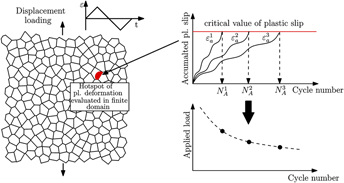Crossref Citations
This article has been cited by the following publications. This list is generated based on data provided by
Crossref.
Wang, Hai-bo
Yang, Xin-hua
Li, He
Song, Guo-lin
and
Tang, Guo-yi
2018.
Enhanced fatigue performance and surface mechanical properties of AISI 304 stainless steel induced by electropulsing-assisted ultrasonic surface rolling process.
Journal of Materials Research,
Vol. 33,
Issue. 22,
p.
3827.
Sajjad, Hafiz Muhammad
Hanke, Stefanie
Güler, Sedat
ul Hassan, Hamad
Fischer, Alfons
and
Hartmaier, Alexander
2019.
Modelling Cyclic Behaviour of Martensitic Steel with J2 Plasticity and Crystal Plasticity.
Materials,
Vol. 12,
Issue. 11,
p.
1767.
Schäfer, Benjamin Josef
Sonnweber-Ribic, Petra
ul Hassan, Hamad
and
Hartmaier, Alexander
2019.
Micromechanical Modelling of the Influence of Strain Ratio on Fatigue Crack Initiation in a Martensitic Steel-A Comparison of Different Fatigue Indicator Parameters.
Materials,
Vol. 12,
Issue. 18,
p.
2852.
Boeff, Martin
Hassan, Hamad ul
and
Hartmaier, Alexander
2019.
On the numerical modeling of nucleation and growth of microstructurally short cracks in polycrystals under cyclic loading.
Journal of Materials Research,
Vol. 34,
Issue. 20,
p.
3523.
Gu, Chao
Lian, Junhe
Bao, Yanping
and
Münstermann, Sebastian
2019.
Microstructure-based fatigue modelling with residual stresses: Prediction of the microcrack initiation around inclusions.
Materials Science and Engineering: A,
Vol. 751,
Issue. ,
p.
133.
Sadananda, K.
Nani Babu, M.
and
Vasudevan, A.K.
2019.
The unified approach to subcritical crack growth and fracture.
Engineering Fracture Mechanics,
Vol. 212,
Issue. ,
p.
238.
Hassan, Hamad ul
Govind, Kishan
and
Hartmaier, Alexander
2019.
Micromechanical modelling of coupled crystal plasticity and hydrogen diffusion.
Philosophical Magazine,
Vol. 99,
Issue. 1,
p.
92.
Fathi Sola, Jalal
Kelton, Randall
Meletis, Efstathios I.
and
Huang, Haiying
2019.
Predicting crack initiation site in polycrystalline nickel through surface topography changes.
International Journal of Fatigue,
Vol. 124,
Issue. ,
p.
70.
Schäfer, Benjamin J.
Song, Xiaochen
Sonnweber-Ribic, Petra
ul Hassan, Hamad
and
Hartmaier, Alexander
2019.
Micromechanical Modelling of the Cyclic Deformation Behavior of Martensitic SAE 4150—A Comparison of Different Kinematic Hardening Models.
Metals,
Vol. 9,
Issue. 3,
p.
368.
Schäfer, Benjamin Josef
Sonnweber-Ribic, Petra
ul Hassan, Hamad
and
Hartmaier, Alexander
2019.
Micromechanical Modeling of Fatigue Crack Nucleation around Non-Metallic Inclusions in Martensitic High-Strength Steels.
Metals,
Vol. 9,
Issue. 12,
p.
1258.
Arnaudov, Nikolai
Kolyshkin, Anton
and
Weihe, Stefan
2020.
Micromechanical modeling of fatigue crack initiation in hydrogen atmosphere.
Mechanics of Materials,
Vol. 149,
Issue. ,
p.
103557.
Natkowski, Erik
Durmaz, Ali Riza
Sonnweber-Ribic, Petra
and
Münstermann, Sebastian
2021.
Fatigue lifetime prediction with a validated micromechanical short crack model for the ferritic steel EN 1.4003.
International Journal of Fatigue,
Vol. 152,
Issue. ,
p.
106418.
Peng, Chao
Pan, Yongzhi
Men, Xiuhua
Jiang, Zhenfeng
and
Fu, Xiuli
2021.
Comprehensive evaluation of surface integrity and parameter optimization of 45 steel subjected to ultrasonic surface rolling process.
Journal of Physics: Conference Series,
Vol. 2044,
Issue. 1,
p.
012123.
Ribeiro, Victor
Correia, José
Mourão, António
Lesiuk, Grzegorz
Gonçalves, Aparecido
De Jesus, Abílio
and
Berto, Filippo
2021.
Low-cycle fatigue modelling supported by strain energy density-based Huffman model considering the variability of dislocation density.
Engineering Failure Analysis,
Vol. 128,
Issue. ,
p.
105608.
Xie, M.W.
Chen, G.
Yang, J.
and
Xu, W.L.
2021.
Temperature- and rate-dependent deformation behaviors of SAC305 solder using crystal plasticity model.
Mechanics of Materials,
Vol. 157,
Issue. ,
p.
103834.
Nazarchuk, Z. Т.
Voronyak, Т. І.
and
Muravsky, L. І.
2021.
Development of the Optical-Digital Methods of Monitoring of the Surfaces of Structural Elements for the Purposes of Technical Diagnostics.
Materials Science,
Vol. 57,
Issue. 3,
p.
344.
Vijay, Akhil
and
Sadeghi, Farshid
2022.
A crystal plasticity and cohesive element model for rolling contact fatigue of bearing steels.
Tribology International,
Vol. 173,
Issue. ,
p.
107607.
Gu, Chao
Lian, Junhe
Lv, Ziyu
and
Bao, Yanping
2022.
Microstructure-Based Fatigue Modeling with Residual Stresses: Effect of Inclusion Shape on Very High Cycle Fatigue Life.
Crystals,
Vol. 12,
Issue. 2,
p.
200.
Yang, Ying
Toure, Mamadou Kabirou
Souare, Papa Momar
Duchesne, Eric
and
Sylvestre, Julien
2022.
Study of underfill corner cracks by the confocal-DIC and phantom-nodes methods.
Microelectronics Reliability,
Vol. 128,
Issue. ,
p.
114431.
Durmaz, Ali Riza
Natkowski, Erik
Arnaudov, Nikolai
Sonnweber-Ribic, Petra
Weihe, Stefan
Münstermann, Sebastian
Eberl, Chris
and
Gumbsch, Peter
2022.
Micromechanical fatigue experiments for validation of microstructure-sensitive fatigue simulation models.
International Journal of Fatigue,
Vol. 160,
Issue. ,
p.
106824.




